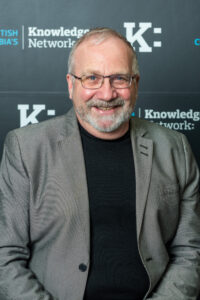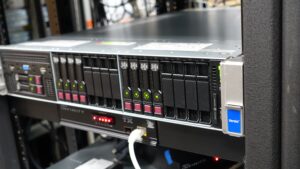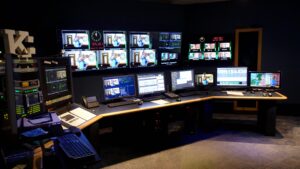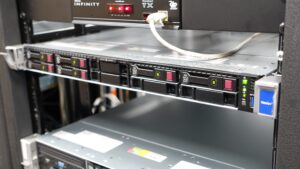
Oliver Eichel, Director of Broadcast Technology and IT, Knowledge Network
Knowledge Network is a different kind of broadcaster with an unusual set of requirements. Based in Vancouver, we are dedicated to the residents of the province of British Columbia, although online content is available across Canada. We are a licensed broadcaster and a registered charity, publicly funded through grants from the provincial government and through donations from viewers.
Knowledge Network does not carry advertising, focusing wholly on supplying consistent, high-quality content, commissioned or acquired from distributors in B.C. and across Canada as well as around the world. The broadcast day is divided into two distinct segments: from 06:00 to 18:00, we offer commercial-free children’s programming, and from 18:00 through the night, we offer a mix of documentaries and factual and drama programming, also commercial-free. To ensure we meet our audience’s high standards in terms of content, we are always conscious that every dollar we spend on infrastructure is a dollar we are not spending on programming.
 But in 2019, our existing playout automation application was reaching the end of its life, and we acknowledged it needed replacement. We considered many options that were available on the market, and drew up a shortlist of three potential suppliers, who we invited to run proof-of-concept trials. Having carefully evaluated what was available, we chose the solution from Imagine Communications, using the widely deployed Versio modular playout platform with the ADC automation control layer.
But in 2019, our existing playout automation application was reaching the end of its life, and we acknowledged it needed replacement. We considered many options that were available on the market, and drew up a shortlist of three potential suppliers, who we invited to run proof-of-concept trials. Having carefully evaluated what was available, we chose the solution from Imagine Communications, using the widely deployed Versio modular playout platform with the ADC automation control layer.
We were fortunate to be able to set up a dedicated test suite at our location to assess and build out the new system. From the test suite we could comfortably prepare for going live with parallel operations and use it to evaluate the special features we had requested. We were able to take advantage of a working schedule that allowed us to participate with Imagine Communications’ R&D staff to refine our workflows. We were able to work out all of the technical requirements for integration of the Versio Workflow and Versio Ingest applications with our other platforms that are required to prepare, move and present our programming. It was an ideal opportunity to iron out workflow details and train the team to handle some of the new functionality that became available. By the time we were ready to switch over in 2020, it was seamless ― the viewers at home definitely did not notice when we went live!
 The Versio architecture is built on a virtualized framework, with many software modules all having hooks into other modules. Right from the start, the benefits of moving to software-based playout technology were evident. Even for requirements as relatively uncomplicated as ours, the old system needed 22 separate pieces of hardware to be integrated and coordinated. The new Imagine-based system has just nine devices, which means savings in real estate in the server room and in cabling, power, and air conditioning, as well as the capital savings in setting the system up.
The Versio architecture is built on a virtualized framework, with many software modules all having hooks into other modules. Right from the start, the benefits of moving to software-based playout technology were evident. Even for requirements as relatively uncomplicated as ours, the old system needed 22 separate pieces of hardware to be integrated and coordinated. The new Imagine-based system has just nine devices, which means savings in real estate in the server room and in cabling, power, and air conditioning, as well as the capital savings in setting the system up.
We were able to take advantage of the streamlined Versio integrated playout architecture, which has allowed us to continue to use our established complex workflows with fewer manual interventions, as well as take advantage of new tools and applications. For example, we typically had to invest in extra hours and manpower to transition during biannual time changes. But with the new Imagine system, this year’s move to Daylight Savings Time was seamless.
Where other broadcasters show commercials, we put a heavy emphasis on interstitials and branding, so the Versio Graphics application’s ability to support dynamic graphics played a big part in our final decision. With our old system, we had to detail all the individual channel branding actions in our BroadView traffic system. Just to make a bug appear, animate, and then disappear could take 26 separate commands. Our brand team had been held back on refreshing and improving our on-air graphics look because it was so labor intensive. Now it is easy.
 Versio Graphics works well with our standard graphics tools and allows our branding team to embed all the instructions inside the graphics file. This means we can schedule in the traffic log a complex graphics event with just one instruction, which makes life easier, obviously, but it also opens up new opportunities. For example, when we recently celebrated the 40th anniversary of Knowledge Network, the branding department was able use the new graphics connectivity to develop special on-air animations ― something we would have been reluctant to do with the old system.
Versio Graphics works well with our standard graphics tools and allows our branding team to embed all the instructions inside the graphics file. This means we can schedule in the traffic log a complex graphics event with just one instruction, which makes life easier, obviously, but it also opens up new opportunities. For example, when we recently celebrated the 40th anniversary of Knowledge Network, the branding department was able use the new graphics connectivity to develop special on-air animations ― something we would have been reluctant to do with the old system.
Our audience tells us they would prefer to read end credits. For this reason, we do not use squeeze backs or other effects that reduces the visibility of the credits, so our channel branding graphics must be flexible to fit into the content. The Versio Graphics application makes it much easier for us to create and command dynamic graphics like “next” and “later” through the use of billboards snipes and animations.
That is particularly important in the children’s half of the day, when some of our programs are just six or seven minutes long. Our children’s schedule is linked by three animated characters: Luna, Chip and Inky (an owl, a beaver and an octopus). We use them as station idents, and they usher our young audiences from one show to the next. These animated graphics are created dynamically on the fly using various templates and the associated metadata.
Versio Graphics supports WAV and MP3 type audio files and enables us to add audio objects to layouts and edit their properties. This is allowing our team to expand the presence of Inky, Chip and Luna by giving them voices so they can attract the attention of our viewers. This will enable an extension to our branding, which will in turn drive audiences to our website and streaming options.
 Overall playout control uses ADC automation from Imagine. This software is widely used and respected around the world, which means that any major traffic/scheduling software provider that might need playout integration will have ADC support. Certainly, our BroadView traffic system integrates seamlessly with ADC.
Overall playout control uses ADC automation from Imagine. This software is widely used and respected around the world, which means that any major traffic/scheduling software provider that might need playout integration will have ADC support. Certainly, our BroadView traffic system integrates seamlessly with ADC.
All of the scheduled broadcast elements are managed from within the Versio and ADC platforms, including ratings classification, Vchip, closed captioning, on-air channel banding and described video.
Looking ahead, our operators are keen to move to the new graphical interface being developed by Imagine. As well as giving the operators more information and clarity, the look of the interface is important. One of the aspects of a publicly-funded broadcaster is that a number of viewers and donors want to come and visit us, and the new graphical interface will aid in describing how the station presents content to the viewers in their home.
What has impressed me about Imagine is that they are very good at planning and managing upgrades while mitigating risk. There are dozens of interconnected applications running at the same time, and any change must be carefully orchestrated. The release notes are detailed and clear, and we can decide whether we need to add any update at any time. Imagine support staff are available and easily scheduled to be on standby when updates and patches are uploaded. That kind of support is invaluable, and I feel very comfortable that I am not taking risks with the on-air signal.
As I mentioned earlier, most stations, including Knowledge Network, have a unique set of requirements, but Imagine listened to what we needed and gave us exactly the right answer. The transition to the new system was seamless, and our staff are very happy as it allows them the freedom to use a variety of new tools to develop a unique viewing experience ― particularly with the station’s branding. We have a platform today that will support us wherever our future plans take us.
Interested in experiencing Versio modular playout in action? Book a live virtual demo.



